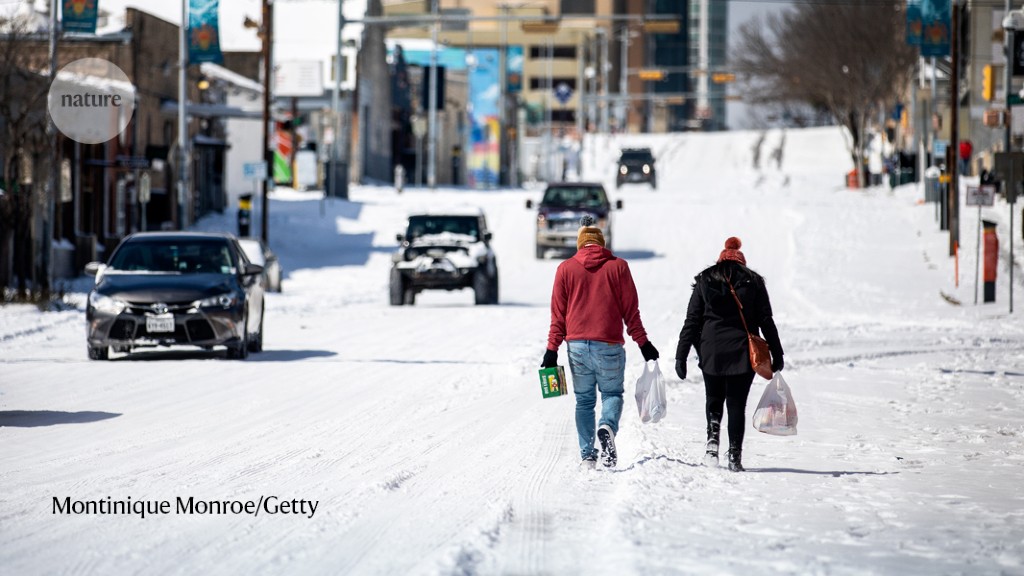Freak US winters linked to Arctic warming

Recent spells of unusually chilly winter climate within the United States and different components of the Northern Hemisphere could possibly be a paradoxical consequence of the local weather warming within the Arctic, in accordance to a research based mostly on a long time of atmospheric observations. However, it’s nonetheless unclear whether or not this represents a long-term development that can persist because the world heats up.
The Arctic’s charge of warming is twice that for Earth as a complete, and a few local weather researchers have lengthy suspected that this speedy Arctic warming can set off anomalies within the winds across the North Pole, with penalties for climate hundreds of kilometres farther south.
“Conventional wisdom is that while global warming means more heatwaves, it will definitely lead to less cold spells and snowfall,” says Judah Cohen, a local weather scientist on the Massachusetts Institute of Technology in Cambridge, and lead creator of the research. “But that’s not quite true. There are mechanisms by which climate change can contribute to more severe winter weather too.”
One dominant function of the winter environment above the Arctic is the polar vortex, a fast-flowing band of high-altitude winds. The vortex usually isolates the environment over the Arctic from hotter air nearer to the Equator. But when the polar vortex stretches and undulates, because it typically does, chilly air can leak out to latitudes that might in any other case hardly ever expertise chilly snaps. Such excessive climate can show deadly in areas unprepared for frosty circumstances — in February, not less than 111 folks died in Texas when chilly Arctic air hit the state and components of northern Mexico.
In their research, printed this week in Science1, Cohen and his colleagues in contrast 40 years of satellite tv for pc observations of atmospheric circumstances over the Arctic with experiments based mostly on computationalclimate fashions. The fashions probed how a decline in Arctic sea ice and snow cowl would have an effect on airstreams within the area. Since ice and snow mirror a big fraction of incoming daylight again into house, whereas the darker ocean and land floor soak up extra radiation, this decline is understood to drive Arctic warming.
The researchers discovered that episodes of polar-vortex stretching have markedly elevated up to now few a long time, and that their fashions reproduced this behaviour effectively after they included the consequences of Arctic warming.
“This is an insightful new analysis,” says Dim Coumou, a local weather scientist on the Free University Amsterdam within the Netherlands, who was not concerned within the research. “Its strength is that they have very carefully looked at a specific pattern of the polar vortex that is important for cold spells in particular places, and backed up their observational analyses with climate-modelling experiments.”
But the concept that Arctic warming could be chargeable for chilly spells in mid-latitude areas remains to be hotly debated amongst local weather scientists. At first look, it may appear apparent that winters will have a tendency to get milder in a warming world. But local weather fashions which can be generally used to research advanced hyperlinks between the completely different parts of the local weather system diverge on the difficulty of how strongly Arctic warming would possibly affect mid-latitude winters, and state-of-the-art fashions don’t precisely replicate noticed tendencies within the behaviour of the polar vortex. It stays to be seen whether or not the fashions are lacking one thing, or whether or not the observations of polar-vortex stretching merely mirror pure local weather variability, says Daniela Matei, a local weather modeller on the Max Planck Institute of Meteorology in Hamburg, Germany, who was not concerned within the research.
The new evaluation doesn’t settle these questions, Matei says. Although adjustments in sea ice and snow cowl do appear to have a job in wind anomalies excessive up above the Arctic, different elements equivalent to decadal variability in sea floor temperatures may additionally drive wintertime anomalies within the Arctic environment that may lead to unexpectedly chilly climate elsewhere, she says. To complicate issues additional, there are nonetheless important uncertainties about how Earth’s local weather as a complete responds to snow and sea-ice adjustments.
For now, it stays unclear whether or not the current examples of utmost winter chilly are precedents for future climate. “Climate change isn’t linear,” Matei says. “What happens in one decade may not apply in the next one.”



